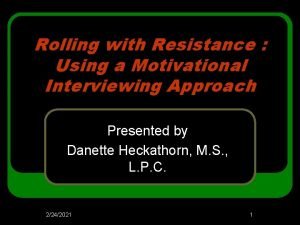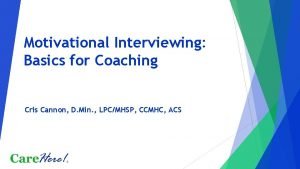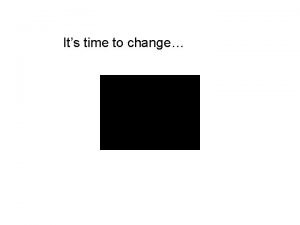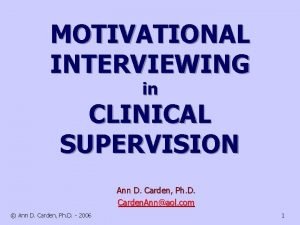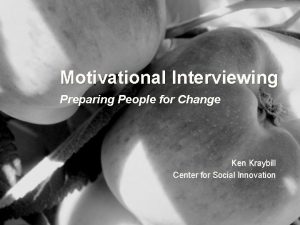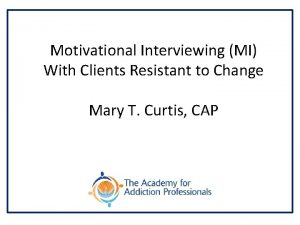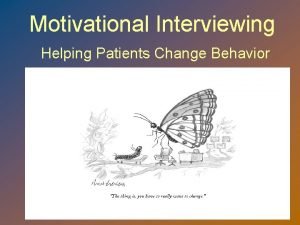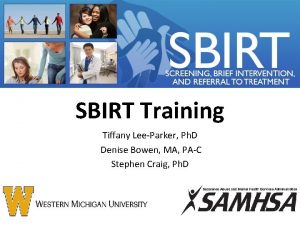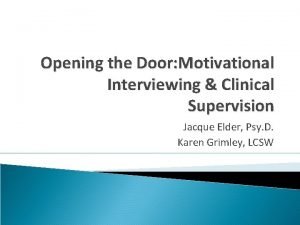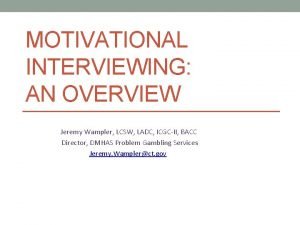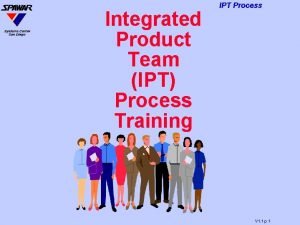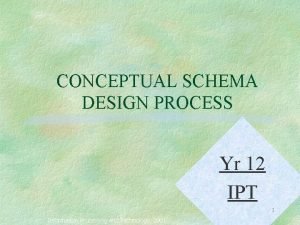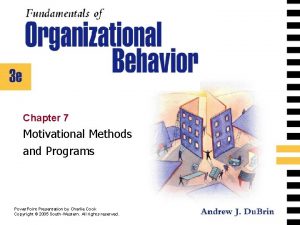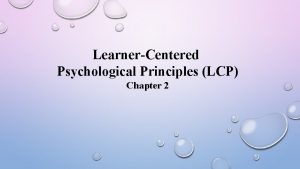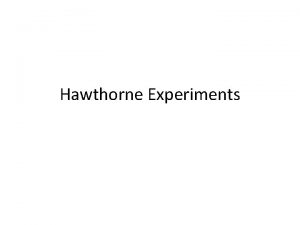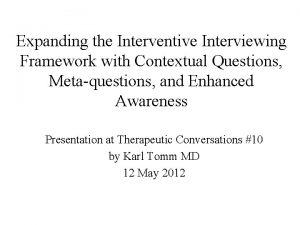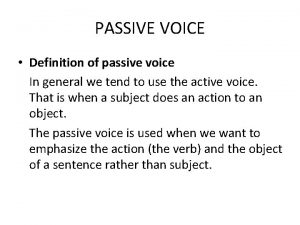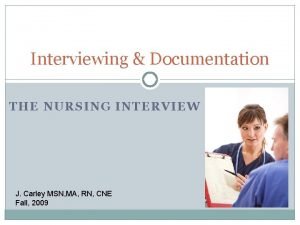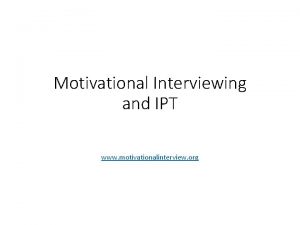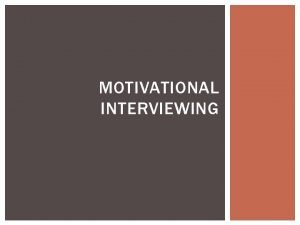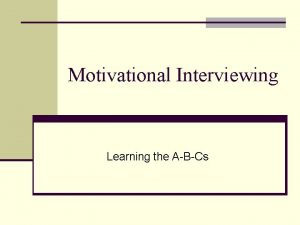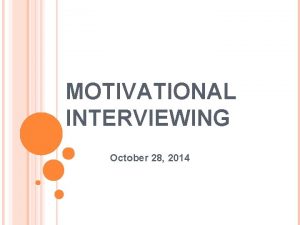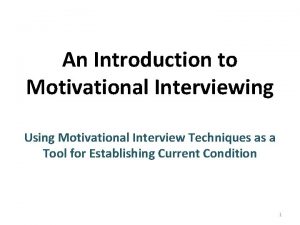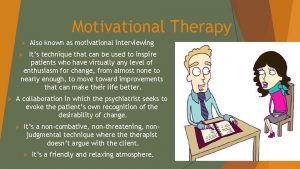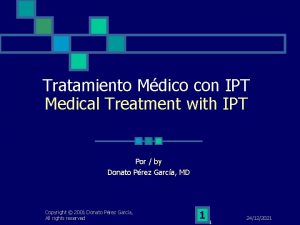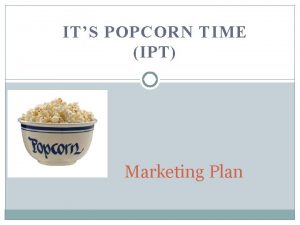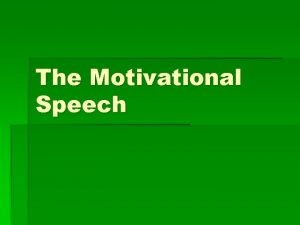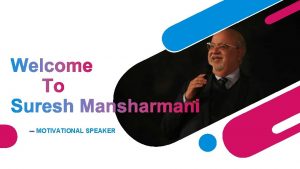Motivational Interviewing and IPT www motivationalinterview org What



















































- Slides: 51

Motivational Interviewing and IPT www. motivationalinterview. org

What behaviors have you tried to change? • Share stories • What was most difficult? • What helped you succeed? • What did you learn in the process?

Five Factors Needed to Increase Intrinsic Motivation 1. Understanding: What is your understanding of the change? 2. Importance: What is most important/meaningful for you in life? How could the change we are working on benefit this? 3. Choice: Where would be a good place to start? 4. Confidence: 1. 2. 3. 4. How confident are you that you can be successful? What are barriers? Is there one that is most important to work on right now? What help and support do you need? 5. Ongoing support: When will we meet next to see how things are going?

Self-determination theory provides the framework for MI Describes three fundamental human needs: 1. Relatedness 2. Competence 3. Autonomy Deci, 1975; Deci & Ryan, 1985; Williams, et al. , 2002


Is this important?

So if Tb is so important, why aren’t we doing better? Clinicians report these barriers to increasing medication adherence “ I don’t have enough time. ” “Patients don’t want to hear about it. ” “I don’t how to help patients change their behaviors. ”

“Not enough time” “Minimal interventions lasting less than 3 minutes increase overall effectiveness. . . ” The PHS Guideline for smoking Strength of Evidence = A

Our training: give lots of advice! • educate, advise, persuade • prescribe action • expect 100% adherence • label those who don’t change “non-compliant” There is a better way!

Exercise • Pair off • Person whose first name is earlier in the alphabet, make a closed fist. • Partner – try and open it w/out wrestling your partner to the ground.

Motivational Interviewing – patient centered 1. therapeutic relationship needed! 2. helps patient recognize the problem 3. ambivalence normal 4. directive in helping client explore ambivalence 5. uses a process paradigm 6. patients know what strategy will work for them “a skillful clinical style for eliciting from patients their own motivation for making changes in the interest of their health” Dr. Michael Goldstein, AACH, VACO

Facilitating health behavior change – a paradigm shift Requires four provider behaviors: 1. Ask with curiosity to create a therapeutic alliance • • Elicit the patient’s perspective Respond with empathy using PEARLS statements 2. Assess patient’s readiness to change • Conviction • Confidence Use reflection when responding to resistance 3. Support the patient’s autonomy; collaborate to tailor a plan for this patient! 4. Provide follow-up

Facilitating health behavior change – a paradigm shift Requires four provider behaviors: 1. Ask with curiosity to create a therapeutic alliance Elicit the patient’s perspective Respond with empathy using PEARLS statements 2. Assess patient’s readiness to change - use reflection • Conviction • Confidence • • 3. Support the patient’s autonomy; engage in collaborative planning to tailor an individual plan 4. Provide follow-up

Facilitating health behavior change Requires four provider behaviors: 1. Create a therapeutic alliance • • Elicit the patient’s perspective – open-ended ? ’s, understand the pt’s explanatory model of illness Respond with empathy 2. Assess patient’s readiness to change • Conviction • Confidence Use Reflection when you encounter resistance 3. Pr. Support the patient’s autonomy; collaborate to tailor a plan for this patient! 4. Provide follow-up

Active Listening 聽 • Be curious, non-judgmental • Don’t impose your values • Look for the emotions underlying the patient’s words • “Give permission” to tell the truth • Use silence • Assure your understanding – clarify and reflect “So if I understand you correctly, you want to protect yourself from getting Tb and you are challenged by adding another medicine. ” • Empathy increases adherence to treatment plan and improves efficiency of consultation.

Move discussion re: adherence into the encounter

Ask with curiosity to create a therapeutic alliance Elicit the patient’s perspective about Tb: ask about the patient’s explanatory model of illness • Fears • Ideas about diagnosis and treatment • Expectations • Complications Stewart et al. , 1990

Take a detailed medication adherence hx WHO - only 50% people take meds as directed 1. What medicines have you taken regularly? 2. What were the challenges with them? 3. How did you overcome those?

Medication Adherence Challenges Category Questions to ask patient Erratic adherence “It is hard to take • Forgetting medicine regularly. Do you sometimes • Med regimen too miss a dose? ” complex “Are you ever • Lack of routine confused about what to take? ” • Too busy to go to clinic “Do you have any trouble getting your medicines? ” “Sometimes I forget to take my meds every day. ” “I can’t get to the clinic to pick up my meds. ” Specific Causes Strategies to Help Simplify therapy Pill box Link meds to other routines such as coffee Reminders by family members Group of 6

Medication Adherence Challenges Category Questions to ask patient Are there meds that you feel you don’t need to take “I don’t need to as often as take this much prescribed? medication” “I don’t like taking Do any of your medicines worry too much you? Do you have medicine” any side effects? “I don’t like the side effect of this Do you ever take less medicine to medicine” make the bottle last longer? Intentional Specific Causes Strategies to Help • Feel better off meds • Acknowledge, discuss and respect concerns, address SE • Explain need to use even when asymptomatic • Side effects bad • Doesn’t seem to be working • Link adherence with therapy to goals • Try to modify treatment to fit this patient!

Medication Adherence Challenges Category Questions to ask patient Tell me how Lack of understanding your doctor asked you to “I think my doctor take this medication told me to …” Specific Causes Strategies to Help • Inadequate • Slow down initial education • Use plain • Language or language cultural • Limit what you differences say and repeat it • Health literacy • Use teach back challenge

Teach Back Method You do NOT want your patients to feel this is a test Place the responsibility on yourself : "I want to be sure that I was clear explaining how to take this medicine. Can you tell me how you will take it? ” OR “Can you tell me how you will explain to your wife/husband/family how you will take this when you get home? ”

Ask with curiosity to create a therapeutic alliance Elicit the patient’s perspective: use OEQs • Requests a story, not an answer • Search is for meaning, not facts • “What” and “How” questions are effective • “Why” questions may provoke defensiveness • Active listening is key Stewart et al. , 1990

Facilitating health behavior change Requires four provider behaviors: 1. Ask with curiosity to create a therapeutic alliance • • Elicit the patient’s perspective Demonstrate empathy using PEARLS statements 2. Inquire about and assess patient’s readiness to change - Conviction - Confidence Use Reflection when you encounter resistance 3. Support the patient’s autonomy; Engage in collaborative planning to tailor an individual plan 4. Provide follow-up

How motivated are they? • Increase motivation for change • Consolidate commitment to change – ie ready to make a plan Prochaska & Di. Clemente, J Consult Clin Psychol 1983

Implications for your counseling For every complex problem, there is a simple answer that is clear, simple and wrong. H. L. Mencken Finding Implication • Most patients are not ready to take action • Movement forward increases the likelihood of subsequent action • Relapse is the norm • Providing action-based strategies to all is ineffective and inefficient • Tailoring strategies to level of readiness is more effective, efficient and satisfying • Prepare and be vigilant for lapses; take a long term view Noar et al. , Psychol Bull 2007

Inquire about and assess readiness to change A patient views change from two separable but interacting perspectives: Conviction: “how important it is to prevent Tb? ” Confidence: “how confident are you that you can take a pill twice a week? ”

Support self-confidence • unless a person thinks they can successfully change, they will be unwilling to try • you can reinforce this – what have they succeeded in doing in the past? • it is highly predictive of action

Conviction and Confidence Convinced 10 Stuck: frustrated Moving: changing Stuck: Unaware or skeptical Stuck: skeptical Conviction Ambivalent 0 Helpless 10 Powerful Confidence

Conviction and Confidence Convinced 10 Stuck: frustrated Moving: changing Stuck: Unaware or skeptical Stuck: skeptical Conviction Ambivalent 0 Helpless 10 Powerful Confidence

Resistance • occurs between people and can be influenced • people normally take sides on any issue • objective is to get the patient to take the “right side” • help patients find the positive part of themselves What does resistance look like in your patients?

What does it mean when a patient says, “I know I have to take my INH!” Often need to clarify: “I want to do it and I am ready to try. ” “I have to do it but I don’t really want to…” “ My family is telling me I have to take it. ” “I’m aware Tb is a problem but I don’t think I CAN take another pill. ” “I’m worthless since I haven’t succeeded!”

Reflection – use when you encounter resistance Listen and try to understand the meaning under the words • Reflect the speaker’s words using short summaries, paraphrasing • Non-verbally remain attentive, non-judgmental

Qualities of a good reflection -clear, concise -accurately identifies the essential meaning underlying a patient’s words -built in pause to give patient an opportunity to elaborate

Types of Reflection • simple reflection “so it is really hard to get the medicine every week. ” • amplified reflection - turn up the heat “ so life is so busy that there is no way you can take another pill. ” • double-sided reflection “so on the one hand you find it really hard to remember but on the other hand you know it is useful to take…” - End with the nugget of motivation

Other strategies for dealing with resistance: - don’t take a position, avoid “should” and “but” - don’t argue with your patient - positive reframe: “My wife nags me all the time to take my medicine…” “So your wife really cares about you, she wants you to stay healthy!”

Reflection Exercise – 5” Demo • Play a patient who is having difficulty taking INH • If patient is resistant, use a reflection to help them move forward • Try to get beyond “It sounds like…” or “ I hear you saying…”

Effects of Reflection Patients: - will explain their ambivalence in depth - feel better understood - correct any misimpressions you more have

Relationship Skills Use the “PEARLS” PEARLS • Partnership “I really want to partner with you to help you make this decision. • Empathy “I can see that you are struggling with your challenges. ” • Appreciation/ “I really appreciate how hard you are working to get on this • Apology medicine. ” “I’m sorry that the clinic wasn’t open when you came. ” • Respect “I really respect how you have dealt with…” • Legitimation “Anyone in your position would feel similarly. ” • Support “ I want to support you …what do you need right now? ”

Skills practice • Imagine a patient you commonly see and have a discussion about taking INH to prevent Tb • Ask about the pros and cons of doing this • Ask about • Conviction • Confidence

Facilitating health behavior change Requires four provider behaviors: 1. Ask with curiosity to create a therapeutic alliance • • • Elicit the patient’s perspective Use reflective listening Demonstrate empathy using PEARLS statements 2. Inquire about and assess patient’s readiness to change • • Conviction Confidence 3. Support the patient’s autonomy; engage in collaborative planning to tailor an individual plan 4. Provide follow-up

Support the patient’s autonomy and engage in collaborative planning “To give your sheep or cow a large, spacious meadow is the way to control him” Shunryu Suzuki Set appropriate objectives • Increased awareness of importance • Increased knowledge • Understand options, choices • Small steps toward change • Strengthen your relationship

Support the patient’s autonomy and engage in collaborative planning • Identify patient’s priorities and negotiate goals • Offer a menu of options and support a choice • Explore and respond to ambivalence • View slips as occasions for problem-solving rather than as failure • Elicit “change talk”

Evoke change talk – including thoughts, beliefs, feelings Look for the patient’s intrinsic motivation to change problem recognition “how does this concern you? ” intention to change future optimism “what might you do? ” “what goals do you have for yourself? ” “what strengths can you draw on to make this change? ”

Summary chart comparing counseling models Traditional Provider Prescriptive Model Motivational Interviewing Model WHAT/WHY (who identifies what behavior needs to change? ) Physician exposes the problem Patient states what matters to them Provider listens for cues and uses: Provider presents facts Open ended questions Affirm and validate Reflect Summarize WHEN (who determines when it is time to change? Provider insists you must start NOW Patient rates importance of change. Patient rates confidence in their ability to change HOW (who determines plan of action for change? Provider insists on action plan Both review patient’s previous successes and failures Patient and provider negotiate action plan and resources needed OUTCOMES Variable rate of success High rate of noncompliance High rate of success

“Teach Back” Associated with Better Blood Sugar Control • Physician visits with low literacy patients audiotaped • 74 patients • 38 physicians • Physicians assessed recall of only 12% of new concepts • When comprehension was assessed, patients were 9 x more likely to have A 1 c below the mean (≤ 8. 6%) Schillinger D et al. Arch Int Med 2003

Interview with Lisa • 28 yo woman who is HIV + • Adherent with ART • Has 3 children, lives miles from clinic

Any Questions? Nancy. Cochran@va. gov

Extra Slides

OARS O – Open ended questions A – Affirmations/ Validations R – Reflections S – Summaries

Ask About Conviction and Confidence “On a scale of 0 - 10, how important is it to you to change behavior X? ” Not at all important 0 1 2 3 4 5 6 7 8 9 10 Completely important “On a scale of 0 - 10, how confident do you feel you can change behavior X? ” Not at all confident Completely confident 0 1 2 3 4 5 6 7 8 9 10
 What does it mean to roll with resistance
What does it mean to roll with resistance Contoh motivational interviewing
Contoh motivational interviewing Motivational interviewing dears
Motivational interviewing dears Motivational interviewing schizophrenia
Motivational interviewing schizophrenia Cris cannon
Cris cannon Motivational interviewing dears
Motivational interviewing dears Desire ability reason need
Desire ability reason need Motivational interviewing stages of change
Motivational interviewing stages of change German motivational speech
German motivational speech Motivational interviewing
Motivational interviewing Ken kraybill
Ken kraybill Double-sided reflection example
Double-sided reflection example Mi readiness ruler
Mi readiness ruler Motivational interviewing
Motivational interviewing Change talk worksheet
Change talk worksheet Dares motivational interviewing
Dares motivational interviewing Stages of change in social work
Stages of change in social work Darn cat motivational interviewing
Darn cat motivational interviewing Motivational interviewing
Motivational interviewing Agreement with a twist motivational interviewing
Agreement with a twist motivational interviewing Sbirt faith and spirituality
Sbirt faith and spirituality Darn cat motivational interviewing
Darn cat motivational interviewing Motivational interviewing
Motivational interviewing Darn cat motivational interviewing
Darn cat motivational interviewing Change talk worksheet
Change talk worksheet Jeremy wampler
Jeremy wampler Krishna guadalupe
Krishna guadalupe Toefl exam
Toefl exam Runipt
Runipt Integrated product team ipt
Integrated product team ipt Ipt wmu
Ipt wmu Fiu ipt
Fiu ipt Schema ipt
Schema ipt Cisco ipt solution
Cisco ipt solution Information processes and technology past papers
Information processes and technology past papers Fiu ipt
Fiu ipt Esta ipt
Esta ipt Apa itu ipt
Apa itu ipt Site:slidetodoc.com
Site:slidetodoc.com Lcp principles
Lcp principles Chapter 7 interviewing candidates
Chapter 7 interviewing candidates Kvale seven stages of interviewing
Kvale seven stages of interviewing Types of interview in social case work
Types of interview in social case work Interviewing in action in a multicultural world
Interviewing in action in a multicultural world Chapter 7 interviewing candidates
Chapter 7 interviewing candidates Bank wiring experiment
Bank wiring experiment Interventive interviewing
Interventive interviewing Definition of passive voice
Definition of passive voice Interviewing techniques for journalists
Interviewing techniques for journalists Performance based interviewing
Performance based interviewing Ten traps of interviewing
Ten traps of interviewing Definition of interview skills
Definition of interview skills
